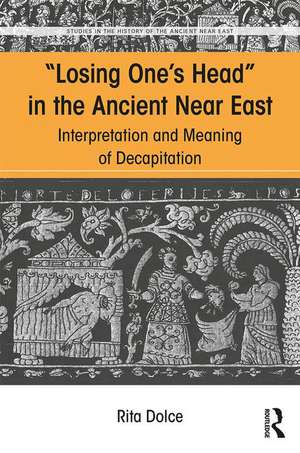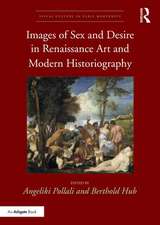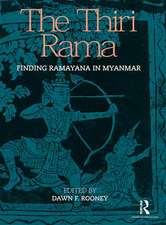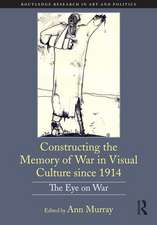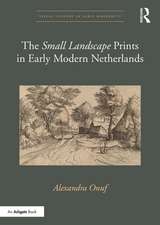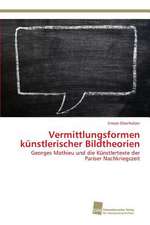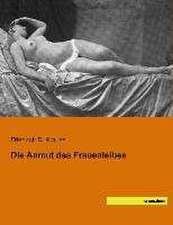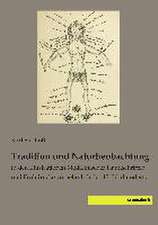Losing One's Head in the Ancient Near East: Interpretation and Meaning of Decapitation: Studies in the History of the Ancient Near East
Autor Rita Dolceen Limba Engleză Hardback – 19 dec 2017
| Toate formatele și edițiile | Preț | Express |
|---|---|---|
| Paperback (1) | 379.09 lei 6-8 săpt. | |
| Taylor & Francis – 14 aug 2020 | 379.09 lei 6-8 săpt. | |
| Hardback (1) | 761.76 lei 6-8 săpt. | |
| Taylor & Francis – 19 dec 2017 | 761.76 lei 6-8 săpt. |
Preț: 761.76 lei
Preț vechi: 1101.37 lei
-31% Nou
Puncte Express: 1143
Preț estimativ în valută:
145.77€ • 153.28$ • 120.44£
145.77€ • 153.28$ • 120.44£
Carte tipărită la comandă
Livrare economică 16-30 aprilie
Preluare comenzi: 021 569.72.76
Specificații
ISBN-13: 9781138067486
ISBN-10: 1138067482
Pagini: 110
Ilustrații: 45 Halftones, black and white
Dimensiuni: 156 x 234 x 11 mm
Greutate: 0.32 kg
Ediția:1
Editura: Taylor & Francis
Colecția Routledge
Seria Studies in the History of the Ancient Near East
Locul publicării:Oxford, United Kingdom
ISBN-10: 1138067482
Pagini: 110
Ilustrații: 45 Halftones, black and white
Dimensiuni: 156 x 234 x 11 mm
Greutate: 0.32 kg
Ediția:1
Editura: Taylor & Francis
Colecția Routledge
Seria Studies in the History of the Ancient Near East
Locul publicării:Oxford, United Kingdom
Cuprins
List of Illustrations
Preface
Acknowledgements
Image Credits
Abbreviations
Introduction
Chapter I
I.1. From the Distant Past to the Recent Past
I.2. An Unrepeatable Act
I.3. The Headless Body: Anonymity/Identity
Chapter II
II.1. Exclusivity/Multiplicity
II.2. Exhibition/Quantification
Chapter III
III.1. What Happens to the "Coveted Object"?
III.2. Destinations/Motivations
III.3. Exhibition and Multivalence
Chapter IV
IV.1. Severed Heads and Birds of Prey
IV.2. Eannatum of Lagash and the Birds of Prey
IV.3. Mari and the Birds of Prey
IV.4. Sargon I of Akkad and the Birds of Prey
IV.5. Dadusha of Eshnunna and the Birds of Prey
IV.6. The Assyrians and the Birds of Prey
Chapter V
V.1. Moving Through Space and Time
V.2. How Does the Head Travel?
Chapter VI
VI.1. "Other" Decapitations in Times of War
VI.2. What Happens to the Severed Heads of Statues?
VI.3. Moving Through Space and Time
VI.4. Annihilation/Catharsis
Bibliography
Index
Preface
Acknowledgements
Image Credits
Abbreviations
Introduction
Chapter I
I.1. From the Distant Past to the Recent Past
I.2. An Unrepeatable Act
I.3. The Headless Body: Anonymity/Identity
Chapter II
II.1. Exclusivity/Multiplicity
II.2. Exhibition/Quantification
Chapter III
III.1. What Happens to the "Coveted Object"?
III.2. Destinations/Motivations
III.3. Exhibition and Multivalence
Chapter IV
IV.1. Severed Heads and Birds of Prey
IV.2. Eannatum of Lagash and the Birds of Prey
IV.3. Mari and the Birds of Prey
IV.4. Sargon I of Akkad and the Birds of Prey
IV.5. Dadusha of Eshnunna and the Birds of Prey
IV.6. The Assyrians and the Birds of Prey
Chapter V
V.1. Moving Through Space and Time
V.2. How Does the Head Travel?
Chapter VI
VI.1. "Other" Decapitations in Times of War
VI.2. What Happens to the Severed Heads of Statues?
VI.3. Moving Through Space and Time
VI.4. Annihilation/Catharsis
Bibliography
Index
Recenzii
"Building on a vast documentary record that covers the entire Syro-Mesopotamian tradition, Dolce's analysis offers an in-depth study in visual semiotics. She identifies specific 'semantic codes' and an explicit syntactical organization, through which a strong message was conveyed by means of visual imagery. This is iconology at its best: by highlighting the coherence of a representational program, and drawing on parallel written statements, our sensitivity is trained to appreciate the 'intrinsic meaning' of a topos such as the action of beheading – a topos with a valence that goes well beyond that of other types of mutilation precisely because of its ideological import."
Giorgio Buccellati, University of California Los Angeles, USA
Giorgio Buccellati, University of California Los Angeles, USA
Descriere
This volume examines the meaning of this specific act in times of war. With examples drawn from Anatolia, Syria and Mesopotamia between the 3rd and 1st millennium BC, from prehistory to the Neo-Assyrian period, this fascinating study will be valuable to anyone interested in the dynamics of war in the ancient world.
Notă biografică
Rita Dolce is Associate Professor of Archaeology and History of Near Eastern Cultures and Fine Arts at the Università degli Studi Roma Tre, Italy, and a member of the Italian Archaeological Mission in Syria, where she has excavated for 40 years at the site of Tell Mardikh-Ebla. Her research interests lie mainly in the figurative art, urban topography and architecture of the third millennium BC in Mesopotamia and Syria. She has written numerous books and articles focusing particularly on visual communication as the language of power and a means of dissemination in the societies of the Ancient Near East, and on the urban origins of Ebla, its palatial culture and the structure and significance of cult places in this important Early Syrian kingdom.
